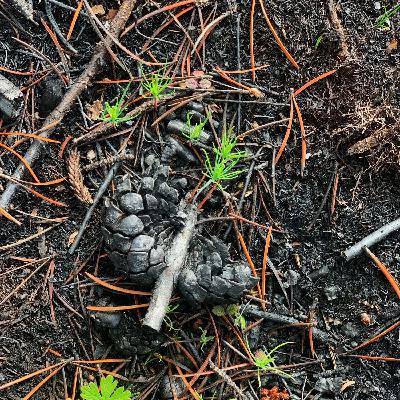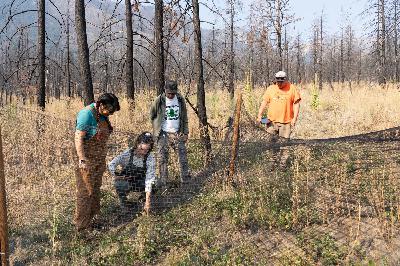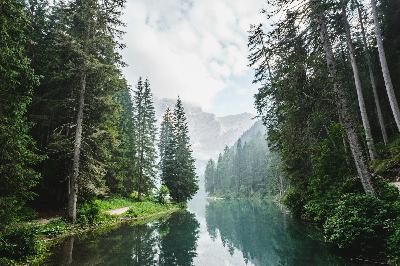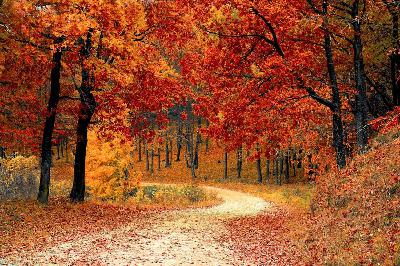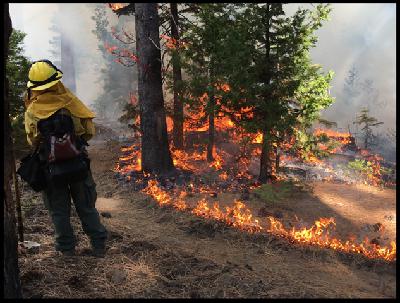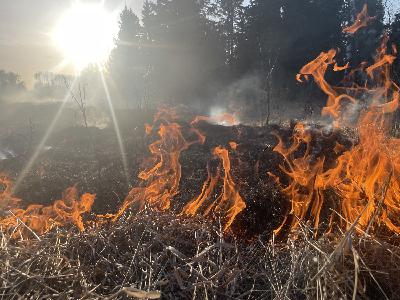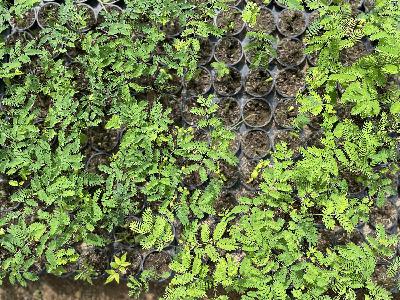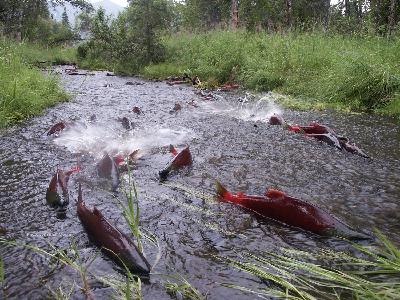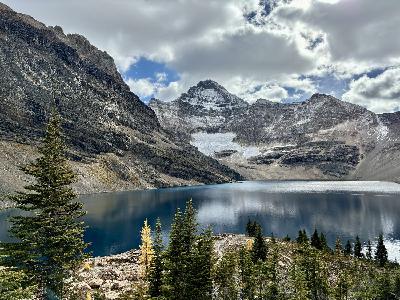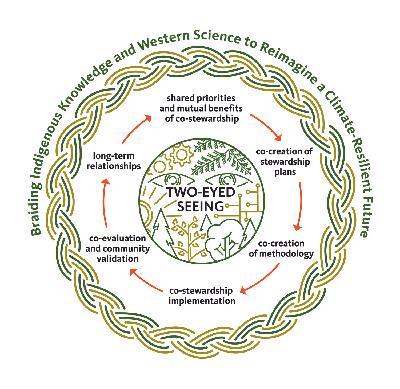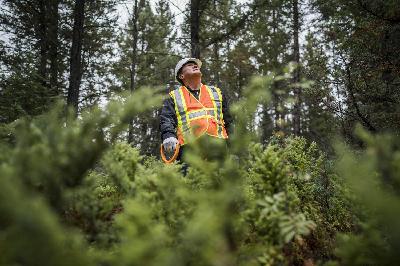Discover YourForest
YourForest

YourForest
Author: Matthew Kristoff
Subscribed: 166Played: 2,930Subscribe
Share
Description
This podcast exists to challenge our ideas of sustainability. Why do we do the things that we do? And how can we make sure that what we are doing is right? This show is an exercise in developing new perspective and context around land management in order to help us make the best decisions possible.
168 Episodes
Reverse
In this episode of YourForest, Matthew Kristoff reflects on his nearly decade-long journey of podcasting and shares key takeaways from the most memorable conversations that have shaped his understanding of forest management, sustainability, and the relationship between humans and nature. This final episode dives into the lessons learned from past episodes, touching on critical topics like decolonization, reconciliation, and how we view and interact with the natural world.🌟 Key Points 🌟👉 Explore how treaties are essential to reconciliation and partnership between Indigenous and non-Indigenous peoples in Canada.👉 Discover "contemplative forestry," a balanced approach that integrates intrinsic values and Western science in forest management.👉 Learn how embracing Indigenous wisdom and Western science can transform forest management for a more sustainable future.👉 Understand the need to uphold scientific integrity in environmental narratives, especially when popular ideas are challenged by research.⌛ Takeaways with Complete Timestamps ⌛[00:00:25] - Matthew’s Final Reflection[00:04:26] - Acknowledgments[00:05:21] - Dr. Matthew Wildcat (Episode 34 – Canada, A Treaty Story[00:23:28] - Dr. Jason Brown (Episode 153 – Learn Contemplative Forestry)[00:34:55] - Gary Merkel (Episode 141 – The Paradigm Shift)[00:52:19] - Connecting the Dots, From Paradigm Shifts to Scientific Integrity[00:57:19] - Justine Karst (Episode 135 – Reconsidering the Wood Wide Web)[01:06:34] - Dr. Jennifer Grenz (Episode 166 – Decolonizing Land Stewardship)Sponsors👉 West Fraser: https://www.westfraser.com/👉 GreenLink Forestry Inc.:https://greenlinkforestry.com/Follow YourForest Podcast on:👉 Website: https://yourforestpodcast.com/👉 YouTube: https://www.youtube.com/@yourforestpodcast7324👉 Facebook: https://www.facebook.com/yourforestpodcast👉 Instagram: https://www.instagram.com/yourforestpodcast/👉 LinkedIn: https://www.linkedin.com/company/yourforestpodcast/👉 Twitter: https://x.com/yourforestpdcst/👉 Email: yourforestpodcast@gmail.comIf you liked this podcast, please rate and review it on your favourite platform! 🌟
Host Matthew Kristoff discusses the launch of the Wildfire Resilience Consortium of Canada (WRCC) with leaders Shelagh Pyper, Kelsey Winter, and Garnet Mierau. The conversation focuses on the urgent need to move past fragmented efforts to a unified, "whole of society" approach for managing Canada's wildfire crisis. The WRCC aims to connect knowledge producers (researchers, firekeepers) with users (policymakers, practitioners) to build national fire resilience.🌟 Key Points 🌟👉 Experts advocate for a societal shift to embrace fire as a beneficial, essential part of life, moving beyond mere coexistence.👉 The WRCC's mission is to end fragmented decision-making by uniting partners, values, and stakeholders in one location.👉 The current period is seen as a key moment in Canadian history to build a robust, holistic, and resilient wildfire future.👉 The next and final YourForest episode will summarize and review the "large-scale lessons learned" throughout the podcast's run.💬 Quotes 💬[00:09:16] Shelagh Pyper: "I'm one of the principals at fuse, and that's what our specialty is, just bridging knowledge, producers with knowledge users and research practitioners, communities, also working with Indigenous communities and Indigenous knowledge and trying to connect those dots."[00:20:11] Kelsey Winter: "Now the wildfire situation is to a point that we're past the tipping point, and if we don't do something different, we'll just keep having the second worst, the first worst season over and over again. So I think the time is now."[00:13:44] Garnet Mierau: "I know, and I believe in this work that it can be done and that connection of the knowledge from the academic side or whether it's an INDIGENOUS fire keeper to that practitioner, that policymaker, that individual on the ground, I know that there's a strong need to make those connections."⌛ Takeaways with Complete Timestamps ⌛[00:00:05] - Embracing Fire as Part of Living[00:00:55] - Podcast Introduction and Host's New Role with the WRCC[00:02:49] - Introduction of Speakers: Roles and Expertise in Fire Resilience[00:05:39] - The Genesis of the WRCC: Addressing Silos in Wildfire Management[00:16:59] - The WRCC as a Network Connector, Not a Singular Centre of Excellence[00:19:39] - Past the Tipping Point: Why the WRCC is Critical Now[00:22:41] - Wildfire as a "Whole of Society" Complex Onion[00:25:50] - Defining and Co-Designing Wildfire Resilience in a Vast Country[00:31:24] - Setting Strategic Priorities: The Three Pillars of Wildfire Management[00:41:36] - Building Trust and Fostering Authentic Collaboration at Scale[01:13:24] - Colonialism and Fire Exclusion as the Core Systemic Problem[01:24:44] - The Need for ActionFollow the guest on:👉 Shelagh Pyper: https://www.linkedin.com/in/shelagh-pyper-73b86813b/👉 Kelsey Winter: https://www.linkedin.com/in/kelsey-l-winter/👉 Garnet Mierau: https://www.linkedin.com/in/garnetmierau/Sponsors👉 West Fraser: https://www.westfraser.com/👉 GreenLink Forestry Inc.:https://greenlinkforestry.com/Follow YourForest Podcast on:👉 Website: https://yourforestpodcast.com/👉 YouTube: https://www.youtube.com/@yourforestpodcast7324👉 Facebook: https://www.facebook.com/yourforestpodcast👉 Instagram: https://www.instagram.com/yourforestpodcast/👉 LinkedIn: https://www.linkedin.com/company/yourforestpodcast/👉 Twitter: https://x.com/yourforestpdcst/👉 Email: yourforestpodcast@gmail.comIf you liked this podcast, please rate and review it on your favourite platform! 🌟
In this episode of YourForest, Matthew Kristoff and Dr. Jennifer Grenz discuss the necessity of decolonizing land management by being "rooted in truth" - acknowledging the historical and ongoing legacies of colonialism that shape current ecological systems. Dr. Grenz, an Nlaka'pamux woman and the Founding Director of the Indigenous Ecology Lab at UBC, advocates for "Two-Eyed Seeing": braiding Indigenous knowledge and Western science to create a stronger, more resilient approach to stewarding our landscapes. The conversation explores how understanding this history is crucial for developing human-centric and effective solutions to environmental challenges.🌟 Key Points 🌟👉 Decolonization is simply acknowledging the full, true history and colonial legacies that impact current land systems.👉 Combine Indigenous knowledge and Western science for a more resilient, complete ecosystem understanding.👉 Rethink static concepts of native species and acknowledge the historical human role in shaping ecology.👉 Prioritize the wisdom and values of relationships to the land and to each other over complex, bureaucratic, knowledge-based systems.💬 Quotes 💬[00:20:28]Dr. Jennifer Grenz: “I just want to work in a way that's congruent with what's on my heart, and I just really don't care what other people think anymore. I think that's also why my lab is structured the way it is. We work entirely in service to indigenous communities. So they're leading the question there, and I'll bring all the scientific tools in. I want to get as much data for them because that's an important knowledge translation exercise. We're gonna use it and analyze it in a different way, or we're going to ask different questions. We're along for their ride and supporting whatever it is that they want for outcomes.”[00:39:50] Dr. Jennifer Grenz: “We can't have reciprocity or anything until we're really grounded in the truth of what it is that we're trying to do. If we were more grounded in truth about what we were trying to do and not try to make one thing another, then we can really talk about what reciprocity looks like in those contexts.”⌛ Takeaways with Complete Timestamps ⌛[00:00:00] Defining Decolonization as "Working in Truth"[00:03:30] The Core Concept of Medicine Wheel for the Planet[00:07:16] Dr. Grenz's Personal Connection to Land[00:11:27] Challenging the Static Idea of Plant Nativeness[00:17:19] Rejecting Objectivity to Work from the Heart.[00:23:34] The Practice of Talking to the Plants.[00:28:27] Humility and Action in Reciprocity[00:44:45] Colonialism as an Ongoing System[01:01:15] Centering the People of the Land[01:17:59] Planting Seeds for Change[01:27:42] Relationship as a Key Guardrail for the FutureFollow the guest on:👉 Dr. Jennifer Grenz LinkedIn: https://www.linkedin.com/in/jengrenz/👉 Medicine Wheel for the Planet: https://www.jennifergrenz.com👉 Indigenous Ecology Lab: https://www.indigenousecology.com/Sponsors👉 West Fraser: https://www.westfraser.com/👉 GreenLink Forestry Inc.:https://greenlinkforestry.com/Follow YourForest Podcast on:👉 Website: https://yourforestpodcast.com/👉 YouTube: https://www.youtube.com/@yourforestpodcast7324👉 Facebook: https://www.facebook.com/yourforestpodcast👉 Instagram: https://www.instagram.com/yourforestpodcast/👉 LinkedIn: https://www.linkedin.com/company/yourforestpodcast/👉 Twitter: https://x.com/yourforestpdcst/👉 Email: yourforestpodcast@gmail.comIf you liked this podcast, please rate and review it on your favourite platform! 🌟
In this episode of YourForest, Matthew Kristoff and guest Shauna Matcovich explore the world of forest finance and the critical role of private capital in funding sustainable forestry. Shauna, a forester and founding director of The ForestLink, discusses the need to link the intrinsic values of a forest - such as its biodiversity and ecosystem health - to a monetary economy in order to drive conservation. The conversation highlights how private investment can be a powerful lever for change and a way to create a more resilient and sustainable forest industry.🌟 Key Points 🌟👉 Connecting Intrinsic Value to Monetary Value: Link intrinsic value to monetary value for a sustainable forest economy.👉 The Power of Private Capital: Private capital can finance sustainable forestry.👉 Beyond Timber: Shift to a holistic approach valuing the full forest.👉 Creative Destruction and New Partnerships: Build new partnerships to unlock the forest's full potential.💬 Quotes 💬[00:00:04] Shauna Matcovich: "We live in a society where a monetary economy is how the world runs. So we need to have a link between these, again, intrinsic existential values that's tied to a monetary value."[00:15:48] Matthew Kristoff: "I think there's so much fear around imperfection that we're holding ourselves back, but we just need to start. We just need to take a step, whether it's perfect or not, just take a step.⌛ Takeaways with Complete Timestamps ⌛[00:00:00] - Introduction to Forest Finance[00:06:28] - Shauna’s Background[00:15:58] - Moving Past the Fear of Imperfection[00:17:32] - The Role of Free Markets[00:21:10] - Involving Private Capital[00:25:17] - The Emergence of Carbon and Biodiversity Credits[00:29:40] - Risk Management in Forest Investment[00:41:37] - The Bioeconomy and Innovation[00:46:45] - Reimagining Value and Partnerships[00:54:02] - Conclusion: Future OpportunitiesFollow the guest on:👉 Shauna Matcovich : https://www.linkedin.com/in/shauna-matkovich-3ab32324/Sponsors👉 West Fraser: https://www.westfraser.com/👉 GreenLink Forestry Inc.:https://greenlinkforestry.com/Follow YourForest Podcast on:👉 Website: https://yourforestpodcast.com/👉 YouTube: https://www.youtube.com/@yourforestpodcast7324👉 Facebook: https://www.facebook.com/yourforestpodcast👉 Instagram: https://www.instagram.com/yourforestpodcast/👉 LinkedIn: https://www.linkedin.com/company/yourforestpodcast/👉 Twitter: https://x.com/yourforestpdcst/👉 Email: yourforestpodcast@gmail.comIf you liked this podcast, please rate and review it on your favourite platform! 🌟
In this episode of YourForest, Matthew Kristoff discusses the future of forestry with Dr. Gary Bull, a leading expert in forestry economics, policy, and sustainability. Dr. Bull, a Professor Emeritus at the University of British Columbia, explores the evolving relationship between forest management, biodiversity, and the forest industry. He emphasizes shifting from timber-focused practices to integrating non-timber values like carbon storage, biodiversity, and ecosystem health. With decades of global experience, Dr. Bull advocates for rethinking forestry to create a more sustainable future.🌟 Key Points 🌟👉 Rethinking the Annual Allowable Cut👉 Circular Bioeconomy and Wood Products👉 Biodiversity and Carbon Credits👉 Balancing Forest Health and Resource Production👉 Indigenous and NGO Collaborations in Forestry💬 Quotes 💬[01:12:16] Dr. Gary Bull: I do appreciate an entrepreneurial spirit and a pioneering spirit and a change in mindset, and that flexibility that comes with being bold and pushing aside that fear so that we can take action and be creative enough. We can figure out how to finance that action. Because if you haven't figured that part out, there's no action going to happen. I'm not dismissing volunteerism at all, and I do think people can contribute in lots of good ways without money being currency. But I do think that this caution and this fear are probably what hold us back the most.[00:26:09] Matthew Kristoff: Industry worried they're going to lose out on business. The government's worried they're going to lose out on tax dollars. These NGOs are worried that we're going to lose ecosystem health and so on and so forth. And it's all fear. Let's move away from the fear. Let's move away from the finger-pointing. Let's try and work together. Let's see what we can do here. Such huge potential. It's amazing. So it's really about changing the value system, changing how we see and incentivize this type of stuff.⌛ Takeaways with Complete Timestamps ⌛[00:00:00] - Introduction to Forestry’s Future[00:04:40] - Dr. Gary Bull’s Background[00:11:40] - Non-Timber Values and the Role of Economics [00:13:54] - The Forest Industry of the Future[00:19:26] - The Case for Pricing Environmental Services[00:22:05] - Global Examples of Collaborative Forest Management [00:26:09] - Breaking Down Barriers Between Industry and NGOs[00:32:17] - Incentivizing Sustainable Forest Management[00:38:30] - The Role of Insurance and Real-Time Monitoring[00:46:18] - The Power of Carbon Accounting[00:55:08] - The Call for Creative Destruction[01:11:11] - Conclusion: Embracing Change for a Sustainable FutureFollow the guest on:👉 Dr. Gary Bull: https://www.linkedin.com/in/gary-bull-739b5511/Sponsors👉 West Fraser: https://www.westfraser.com/👉 GreenLink Forestry Inc.:https://greenlinkforestry.com/Follow YourForest Podcast on:👉 Website: https://yourforestpodcast.com/👉 YouTube: https://www.youtube.com/@yourforestpodcast7324👉 Facebook: https://www.facebook.com/yourforestpodcast👉 Instagram: https://www.instagram.com/yourforestpodcast/👉 LinkedIn: https://www.linkedin.com/company/yourforestpodcast/👉 Twitter: https://x.com/yourforestpdcst/👉 Email: yourforestpodcast@gmail.comIf you liked this podcast, please rate and review it on your favourite platform! 🌟
In this episode of YourForest Podcast, host Matthew Kristoff is joined by Kelly Cooper, founder of the Free to Grow in Forestry initiative, and Greg Herringer, chair of the Canadian Institute of Forestry’s DEI leadership team. Through honest and eye-opening conversation, they unpack why change is so difficult, highlighting deep-rooted resistance, fear of change, and power dynamics that hold progress back. Kelly shares her personal experience of being excluded from the very DEI work she was leading, while Greg reflects on how bias shows up in both personal and professional spaces. 🌟 Key Points 🌟👉 DEI in Forestry Faces Systemic Resistance👉 Kelly Cooper’s Experience Reflects the Broader Challenge👉 Invisible Privilege Shapes Workplace Dynamics👉 Allyship Requires Action, Not Just Agreement👉 Cultural Change Requires Structural Support👉 Emotional Intelligence Is a Key Leadership Skill💬 Quotes 💬[00:11:06] Greg Herringer: “Our culture isn't as far as long as we would like to believe.”[00:27:52] Kelly Cooper: “I wrote a book called Lead the Change The Competitive Advantage of Gender Diversity and Inclusion. And the reason I wrote that is because I could see quite clearly there was a gap in the leadership levels of understanding this and common-sense way.”[00:13:35] Matthew Kristoff: “It's easy for me to have rose colored glasses. I think I'm optimistic. Like, things are good, life is good. We're going well. But then you talk to Kelly and you're like, oh, well, shit.”⌛ Takeaways with Complete Timestamps ⌛[00:00:00] - Introduction & Theme Setup.[00:06:52] - Kelly Cooper’s Background & Motivation[00:09:46] - Greg Herringer’s Story & Racial Awareness2a[00:17:32] - Launch and Growth of Free to Grow in Forestry[00:26:17] - Breakdown of the Initiative and Industry Pushback[00:35:03] - Institutional and Psychological Resistance[00:42:50] - The Impact of Exclusion and Bystander Culture[00:54:00] - Leadership Bias and Power Dynamics[01:08:00] - Redefining Allyship: From Support to Accompliceship[01:13:10] - Tools for Change and Empathy in Practice[01:18:38] - Emotional Impact and Reputational Harm[01:27:12] - Rebuilding DEI Momentum & Leadership Accountability[01:49:55] - Conclusion: Staying the Course and Hope for the Future🔗 Important Links:👉 Canadian Institute of Forestry: https://www.cif-ifc.org/👉 Free to Grow in Forestry: https://www.cif-ifc.org/what-we-do/free-to-grow/👉 Lead the Change: The Competitive Advantage of Gender Diversity and Inclusion: https://a.co/d/5yAbpUp👉 Greenlink Forestry Ltd: https://www.greenlinkforestry.co.uk/👉 Registered Professional Foresters: https://www.fpbc.ca/become-a-forest-professional/registered-professional-foresters/👉 On Tyranny: Twenty Lessons from the Twentieth Century: https://a.co/d/fWV2HlFFollow the Guests on:👉 Kelly Cooper: https://www.linkedin.com/in/kelly-cooper-6b742966/ 👉 Greg Herringer: https://www.linkedin.com/in/greg-herringer-48882a109/Sponsors👉 West Fraser: https://www.westfraser.com/👉 GreenLink Forestry Inc.: https://greenlinkforestry.com/Follow YourForest Podcast on:👉 Website: https://yourforestpodcast.com/👉 YouTube: https://www.youtube.com/@yourforestpodcast7324👉 Facebook: https://www.facebook.com/yourforestpodcast👉 Instagram: https://www.instagram.com/yourforestpodcast/👉 LinkedIn: https://www.linkedin.com/company/yourforestpodcast/👉 Twitter: https://x.com/yourforestpdcst/👉 Email: yourforestpodcast@gmail.comIf you liked this podcast, please rate and review it on your favourite platform! 🌟
This YourForest Podcast episode, featuring experts Marissa Christansen and Chris Anthony, argues for a fundamental shift in how we handle wildfires. They advocate for "intentional fire" – using practices like prescribed burns and Indigenous cultural burning. This approach helps keep landscapes healthy, reduces the risk of massive wildfires, and even revitalizes cultural practices. The conversation highlights the need to empower local communities in fire management, evolve the role of firefighters beyond just suppression, and overcome public fear and outdated regulations that hinder the adoption of these beneficial fire practices.🌟 Key Points 🌟👉 Intentional Fire is Essential👉 Decentralized Decision-Making Builds Resilience👉 Firefighting Culture Must Evolve👉 Policy Change is Crucial but Slow👉 Public Perception is a Major Barrier👉 Insurance and Incentive Structures Must Adapt💬 Quotes 💬💬 [00:00:05] Chris Anthony: "The scale of change is occurring faster than our ability to adapt to it, but also to mitigate it. And I think that's where the complexity comes in. So if we continue to use the same tools, the same mindsets, the historical approach or the cultural approach that we've had, that's not going to change what the future is going to look like."💬 [00:36:47] Marissa Christansen: "It's a good kind of catchall phrase for a bunch of different helpful, beneficial fire types that can be a part of our toolbox. One of those practices is cultural burning by our indigenous tribes, both here in the United States and in Canada. A lot of these tribes have practices that they've been doing for thousands of years, long before we got here, as a way of both demonstrating their cultural norms as well as managing the landscape that they have been stewards of for all this time."💬 [01:42:08] Matthew Kristoff: “If we can start to understand and realize a cultural reciprocity with fire, all of a sudden, this is just something we talk about and think about and converse about. If everyone's doing it, you're going to see solutions so much faster, that's just that cultural shift is going to be so powerful.”⌛ Takeaways with Complete Timestamps ⌛[00:00:00] – Introduction to the Episode & Guests [00:03:15] – Defining Intentional Fire[00:11:23] – The Role of the Climate and Wildfire Institute (CWI)[00:17:58] – Why Traditional Firefighting Approaches Fall Short[00:26:27] – Rethinking the Firefighting Workforce[00:36:41] – What is Intentional Fire? Why It Matters[00:43:12] – Public Perception & Cultural Change[00:59:14] – Indigenous Fire Stewardship & Policy Progress[01:03:42] – Regulatory & Institutional Barriers[01:17:05] – CWI Convenings & Cross-Sector Dialogues[01:23:02] – Insurance Reform & Risk-Based Mitigation[01:30:59] – Rebuilding After Fire: Missed Opportunities[01:35:50] – Unlocking Local Response Capacity[01:42:44] – Vision for the Future 🔗 Important Links:👉 Intentional Fire Website: https://intentionalfire.org/👉 The Stewardship Project: https://climateandwildfire.org/cwi-projects/the-stewardship-project/👉 CWI Signature Convenings: https://climateandwildfire.org/our-work/cwi-events/👉 CWI Blog: https://climateandwildfire.org/blog/Follow the Guests on:👉 Marissa Christansen’s LinkedIn: https://www.linkedin.com/in/marissa-christiansen-4784566/👉 Chris Anthony’s LinkedIn: https://www.linkedin.com/in/cjanthony/Sponsors👉 West Fraser: https://www.westfraser.com/👉 GreenLink Forestry Inc.: https://greenlinkforestry.com/Follow YourForest Podcast on:👉 Website: https://yourforestpodcast.com/👉 YouTube: https://www.youtube.com/@yourforestpodcast7324👉 Facebook: https://www.facebook.com/yourforestpodcast👉 Instagram: https://www.instagram.com/yourforestpodcast/👉 LinkedIn: https://www.linkedin.com/company/yourforestpodcast/👉 Twitter: https://x.com/yourforestpdcst/👉 Email: yourforestpodcast@gmail.comIf you liked this podcast, please rate and review it on your favorite platform! 🌟
In this episode of the YourForest Podcast, Matthew Kristof explores the essential role of dialogue in effective landscape and wildfire management. Joined by Robin Freeman, Project Manager for the Wildfire Networks at the SFU Centre for Dialogue, and James Whitehead, Special Projects Manager for the Mitigating Wildfires Project, they dive into how open, empathetic communication can help diverse stakeholders collaborate toward better environmental management solutions.The discussion covers the intricacies of dialogue as a tool for conflict resolution, the challenges of managing wildfire risks, and the importance of understanding differing perspectives in environmental decision-making. The conversation highlights the need for vulnerability and honesty, both from facilitators and participants, in creating an environment where meaningful dialogue and change can happen.🌟 Key Points 🌟👉 Dialogue Goes Beyond Conversation - Dialogue is more than just talking—it’s a structured process that requires active listening, empathy, and a willingness to engage with different perspectives. By fostering this, stakeholders can move toward sustainable solutions in landscape management.👉 Conflict is Not to be Avoided - It’s an Opportunity - James and Robin highlight that conflict, when handled respectfully, is an opportunity for innovation. By embracing disagreement and seeing it as a chance to understand differing perspectives, stakeholders can arrive at better solutions.👉 The Role of Facilitators in Navigating Complex Conversations - Facilitators are crucial in managing conversations, especially when disagreements arise. Their job is not to lead the conversation but to create a safe, respectful space where all participants can share their views and build mutual understanding.👉 Empathy is Key to Understanding and Collaboration - Empathy is the cornerstone of effective dialogue. Understanding the personal and emotional context behind others’ views helps participants move from a place of disagreement to one of cooperation.👉 Create Structured Opportunities for Participation - Robin and James emphasize the importance of using techniques that allow everyone to have a voice, especially in large group settings. By creating structured opportunities for sharing and collaborating, facilitators can ensure that even the quietest participants are heard.💬 Quotes 💬💬 [00:00:05 - 00:00:24]Robin Freeman: "The system as a whole will be healthier if we hear from more parts of the system. It's this idea that nobody has a monopoly on the truth, and so we actually need as many people as possible sharing their point of view so that we can make good decisions, because otherwise we don't see the whole picture, and no one will ever see the whole picture.”💬 [00:59:21 - 01:00:29] James Whitehead: "The role of a facilitator is really to hold space for a conversation and to hold space for the conversation that needs to happen... The goal of the effective facilitator is to really be the one to enable that conflict to happen in a productive and respectful and safe way.💬 [00:36:12-00:36:39] Matthew Kristof: “Conflict is just two, or more, very passionate people are arguing passionately about something they care about. And you're like, Why is conflict bad? Why do we see conflict as a bad thing? As long as we can be mature about it, then all of a sudden, conflict becomes an opportunity.”⌛ Takeaways with Complete Timestamps ⌛[00:00:00] - Introduction to Dialogue and Its Role [00:06:39] - Understanding the Role of Conflict in Dialogue [00:17:11] - The Importance of dialogues[00:22:12] - Disagreeing Collaboratively [00:38:36] - Building Safe Spaces for Difficult Conversations[00:47:30] - Case Study: Wildfire Management and Dialogue[00:52:04] - Overcoming the Fear of Conflict[01:05:42] - Creating Impactful Conversations in Landscape Management.[01:08:50] - Understanding Shared Values in Landscape Management [01:15:27] - Final Thoughts on Facilitating Change through DialogueImportant Links:👉 I and Thou: Martin Buber's Philosophy of Dialogue - https://youtu.be/AT6wEZfotVI?feature=shared👉 TED talk from Myrna Lewis - https://www.youtube.com/watch?v=FsFz1H447kk&t=49s👉 Links for Conflict is Opportunity - https://www.youtube.com/watch?v=AT6wEZfotVI👉 Complex Systems Frameworks Collection - https://www.sfu.ca/complex-systems-frameworks/frameworks/complex-vs-complicated/cynefin.html👉 Polarity Management - A Summery Introduction - https://rise-leaders.com/wp-content/uploads/2019/07/Polarity-Management-Summary-Introduction.pdf👉 Practical Lessons From A Mediator’s Notebook - https://www.theconflictjourney.com/2017/09/29/adam-kahane-collaborate-with-enemy/Follow the Guests on:👉 James Whitehead LinkedIn: https://www.linkedin.com/in/jamesmwhitehead/👉 Robin Freeman LinkedIn: https://www.linkedin.com/in/robin-freeman-ed-d-73b4a8212/Sponsors👉 West Fraser: https://www.westfraser.com👉 GreenLink Forestry Inc.: https://greenlinkforestry.com/Follow YourForest Podcast on:👉 Website: https://yourforestpodcast.com👉 YouTube: https://www.youtube.com/@yourforestpodcast7324👉 Facebook: https://www.facebook.com/yourforestpodcast👉 Instagram: https://www.instagram.com/yourforestpodcast/👉 LinkedIn: https://www.linkedin.com/company/yourforestpodcast/👉 Twitter: https://x.com/yourforestpdcst/👉 Email: yourforestpodcast@gmail.comIf you liked this podcast, please rate and review it on your favorite platform! 🌟
Welcome to YourForest Podcast, where Matthew Kristoff and James Whitehead navigate the crucial role of dialogue in managing environmental challenges, particularly wildfire mitigation. This episode not only highlights the importance of understanding and engaging in effective dialogue but also emphasizes the need for diverse stakeholders to come together and tackle environmental issues collaboratively.Explore how structured conversations can lead to actionable insights and stronger, more inclusive solutions for landscape management. Don’t miss the insights shared by James on how dialogue can transform the approach to environmental management and foster a culture of collaboration and mutual understanding.🌟 Key Takeaways 🌟- The Essence of Dialogue in Environmental Management: James Whitehead emphasizes the importance of dialogue not just as conversation but as a structured, inclusive process that engages diverse opinions to foster understanding and collaboration among stakeholders in environmental sectors, particularly in wildfire management.- Barriers to Effective Dialogue: The episode delves into both psychological and logistical challenges that hinder effective dialogue, highlighting how biases and institutional structures can obstruct collaborative problem-solving in environmental contexts.- Collaborative Disagreement: A significant focus is on the concept of "disagreeing collaboratively," where stakeholders learn to engage with conflicting viewpoints constructively, allowing for the development of innovative and comprehensive solutions to complex environmental challenges.- Impact of Wildfire Management Discussions: Discussion around wildfire management in BC illustrates the complex interplay of various stakeholder goals and the realities of implementing practical wildfire mitigation strategies on the ground.💬 Quotes 💬- [00:23:34-00:23:47] James Whitehead: “There's something incredibly powerful when you see that switch flick in a room and all of a sudden people get excited, and that I think when you see people get excited and engaged, I think it means that something switched with them.”- [01:00:13-01:00:29] Matthew Kristoff: “ Step out of their own shoes, step into somebody else's, and really consider what it would be like to be in their situation and how important that would be and how that would affect their life. And then, step back into your own shoes and go. Think how I can become more comprehensive. How can I become more empathetic?”⌛ Takeaways with Complete Timestamps ⌛[00:01:18] - Introduction to Dialogue and its Role[00:06:26] - James Whitehead’s Background[00:17:05] - Understanding Dialogue[00:21:54] - Challenges of Effective Dialogue[00:38:52] - Case Studies and Examples[00:46:43] - Disagreeing Collaboratively[01:11:21] - Closing Thoughts and Future DirectionsFollow the Guests on:LinkedIn: 👉 https://www.linkedin.com/in/jamesmwhitehead/Sponsors👉 West Fraser: https://www.westfraser.co👉 GreenLink Forestry Inc.:https://greenlinkforestry.com/Follow YourForest Podcast on:👉 Website: https://yourforestpodcast.com/👉 YouTube: https://www.youtube.com/@yourforestpodcast7324👉 Facebook: https://www.facebook.com/yourforestpodcast👉 Instagram: https://www.instagram.com/yourforestpodcast/👉 LinkedIn: https://www.linkedin.com/company/yourforestpodcast/👉 Twitter: https://x.com/yourforestpdcst/👉 Email: yourforestpodcast@gmail.comIf you liked this podcast, please rate and review it on your favorite platform! 🌟
Welcome to YourForest Podcast, where we explore the interconnections between environmental science, sustainability, and the human connection to nature. In this captivating episode, hosted by Matthew Kristoff, we engage in a deep dive with Mike Leahy and Rebecca Quiñonez-Piñón about the enchanting world of the Monarch butterfly and the concerted efforts required for their conservation.The episode features Mike Leahy, the Senior Director for Wildlife Hunting and Fishing Policy at the National Wildlife Federation, and Rebecca Quiñonez-Piñón who serves as the Senior Scientist at the National Wildlife Federation. Both guests share their deep insights on the challenges facing Monarch butterflies and outline practical steps for their conservation.🌟 Key Takeaways 🌟- Extensive Role of the National Wildlife Federation: Explore how the Federation, under Mike Leahy’s leadership, addresses crucial wildlife conservation issues, including those affecting the Monarch butterfly.- Monarch Butterfly’s Charisma and Cultural Significance: Rebecca highlights the deep cultural and emotional connections that people, particularly in Mexico, share with the Monarch butterfly, which is intertwined with their life cycle and migratory patterns.- Challenges in Monarch Conservation: The discussion sheds light on the various threats that monarch populations face, such as habitat destruction, pesticide use, and climate change, emphasizing the urgent need for strategic conservation efforts.- Impact of Community and Educational Involvement: Learn about the significant role that community actions, like planting native milkweeds and educational programs in schools, play in conserving the Monarch butterfly.- Vision for Ultimate Conservation Strategies: Mike and Rebecca share their ideal approaches to monarch conservation, imagining the impact of unlimited resources on enhancing habitat and public engagement.💬 Quotes 💬- Mike Leahy: “We’re the nation's largest conservation organization, and we work on pretty much anything and everything related to wildlife and species conservation.”- Rebecca Quiñonez-Piñón: “For some reason, the monarch has that amazing ability to embed that memory during your childhood... in Mexico, the monarch is part of the celebration of the Day of the Dead.”⌛ Takeaways with Complete Timestamps ⌛[00:01:08] - Introduction of the episode[00:04:09] - Mike Leahy’s introduction and background[00:07:35] - Rebecca Quiñonez-Piñón’s journey to monarch conservation[00:10:41] - The Charismatic nature of the Monarch butterfly[00:27:36] - The Importance of habitat and native milkweed[00:41:53] - Public engagement in conservation[01:03:20] - Ultimate conservation strategies[01:06:13] - Concluding segmentFollow the Guests on:Mike Leahy’s LinkedIn:👉 https://www.linkedin.com/in/mike-leahy-89a4a211/Rebecca Quiñonez-Piñón’s LinkedIn:👉 https://www.linkedin.com/in/rebeca-qui%C3%B1onez-pi%C3%B1%C3%B3n-2b676417/Monarch Recovery Repository Page:👉 https://monarchs.nwf.org/Plant Native Site, NWF:👉 https://www.nwf.org/Native-Plant-Habitats/Plant-NativeSponsors👉 West Fraser: https://www.westfraser.co👉 GreenLink Forestry Inc.:https://greenlinkforestry.com/Follow YourForest Podcast on:👉 Website: https://yourforestpodcast.com/👉 YouTube: https://www.youtube.com/@yourforestpodcast7324👉 Facebook: https://www.facebook.com/yourforestpodcast👉 Instagram: https://www.instagram.com/yourforestpodcast/👉 LinkedIn: https://www.linkedin.com/company/yourforestpodcast/👉 Twitter: https://x.com/yourforestpdcst/👉 Email: yourforestpodcast@gmail.comIf you liked this podcast, please rate and review it on your favorite platform! 🌟
Welcome to YourForest Podcast, where we explore the vital connections between environmental science, sustainability, and the essential role of forests. This enlightening episode of the YourForest Podcast, hosted by Matthew Kristoff features an engaging discussion with Dr. Amy Cardinal Christianson who serves as the Senior Fire Advisor at the Indigenous Leadership Initiative, where she spearheads efforts to support Indigenous fire stewardship. The episode explores how indigenous practices and guardianship programs contribute to the conservation and sustainable management of natural resources. Dr. Christianson, a wildfire researcher focusing on Indigenous fire stewardship, delves into her new role at the Indigenous Leadership Initiative.🌟 Key Takeaways 🌟- Guardian Movements and IPCA: Dr. Christianson illustrates the importance of these initiatives in providing indigenous communities with control over their lands and preserving their cultural heritage.- Role of Indigenous Leadership in Conservation: Learn how the ILI supports indigenous governance and sustainable land management, enhancing community resilience and environmental protection.- Supporting Indigenous Sovereignty: The discussion emphasizes the significance of indigenous-led conservation in fostering long-term sustainability within Indigenous communities.- Challenges and Achievements in Indigenous Leadership: Insights into the bureaucratic hurdles and the progress made in recognizing and supporting Indigenous rights and governance.- Community and Cultural Impact: This episode highlights the role of community involvement in successful conservation efforts and the benefits of culturally relevant environmental practices.💬 Quotes 💬- "Indigenous people have had a disconnection from that culture, right? And so one thing that guardian movements or Indigenous protected conserved areas also does is allows for opportunities for knowledge sharing." - Amy Cardinal Christianson- "I can't even imagine because of the red tape and the political niceties and you're like, no, at the end of the day, this is a problem that needs to be fixed. But you can't beat around the bush.” - Matthew Kristoff ⌛ Takeaways with Complete Timestamps ⌛[00:00:05] - Teaser- How guardian programs help Indigenous communities.[00:01:06] - Introduction of the guest[00:03:58] - Career Shifts and the Impact of Indigenous Frameworks[00:05:54] - Impact of Guardian Programs on Local Communities.[00:10:55] - Challenges and Future Directions in Indigenous Conservation.[00:19:04] - Communication and Advocacy in Indigenous Environmental Efforts.[00:37:00] - Complicity Over Allyship in Supporting Indigenous Causes.[00:53:48] - Bridging Professional and Cultural Work.Follow the guest Amy Cardinal-Christianson on:👉 Linkedin: https://www.linkedin.com/in/amy-cardinal-christianson-8b168243/👉 Twitter: https://x.com/ChristiansonAmySponsors👉 West Fraser: https://www.westfraser.com/👉 GreenLink Forestry Inc.: https://greenlinkforestry.com/Follow YourForest Podcast on:👉 Website: https://yourforestpodcast.com/👉 YouTube: https://www.youtube.com/@yourforestpodcast7324👉 Facebook: https://www.facebook.com/yourforestpodcast👉 Instagram: https://www.instagram.com/yourforestpodcast/👉 LinkedIn: https://www.linkedin.com/company/yourforestpodcast/👉 Twitter: https://x.com/yourforestpdcst/👉 Email: yourforestpodcast@gmail.comIf you liked this podcast, please rate and review it on your favorite platform! 🌟
Welcome to YourForest Podcast, where we explore the vital connections between environmental science, sustainability, and the essential role of forests. In today’s episode join host Matthew Kristoff on YourForest Podcast for an inspiring conversation with Lauren Oakes, scientist, storyteller, and author of Tree Keepers: The Race for a Forested Future. This episode delves into the global reforestation movement, addressing the challenges and opportunities of using forests as a solution to climate change. Lauren unpacks the intricate debates surrounding tree planting versus forest restoration, highlighting the importance of thoughtful stewardship, community involvement, and long-term sustainability.Drawing from her research and personal experiences, Lauren explores how forests can be integrated into human and ecological systems, biodiversity benefits, and improved community well-being. She emphasizes the role of local support and economic incentives in sustaining reforestation projects. Whether discussing urban tree equity or global forest management, Lauren offers actionable insights to help listeners become active participants in creating a more resilient, forested future.🌟 Key Takeaways 🌟– Planting Trees vs. Planting Forests: Lauren explains the difference between individual tree planting and creating resilient, biodiverse forests that sustain ecosystems and provide long-term benefits for carbon sequestration, biodiversity, and human well-being.– Economic Viability and Local Involvement: For reforestation projects to succeed, they must align with the economic and social needs of local communities. Collaborative approaches and economic incentives are key to sustaining these initiatives.– Reforestation Challenges and Opportunities: From funding gaps to ensuring tree survival, Lauren highlights the challenges of reforestation projects while showcasing innovative solutions like agroforestry and community-driven restoration.– Action at All Levels: Whether through global commitments like the Trillion Trees initiative or individual efforts in urban and rural areas, everyone has a role to play in becoming a tree keeper.💬 Quotes 💬"We are all tree keepers in some way. We can also think about the nature in our backyards and in our communities, the green spaces and forests and trees, and how to be better stewards of them in our communities" - Lauren Oakes"Our brains, our society has forced us to really like we value everything in dollars. So if we can value nature in dollars, all of a sudden it computes. And then when you can put a dollar value to it, you're like, oh, I see and start to think about it a little bit more" - Matthew Kristoff⌛ Take away with complete timestamps ⌛[00:04:30] - Introduction to Lauren Oakes[00:07:34] - Why the World is Turning to Trees[00:11:08] - Planting Trees vs. Restoring Forests[00:20:08] - The Global Forest Landscape: Then and Now[00:30:30] - Reforestation in the Right Places[00:33:36] - Indigenous Knowledge and Forest Stewardship[00:45:18] - Sustainable Relationships with Forests[00:51:18] - Maximizing Forest Value Beyond Carbon[01:08:40] - Bridging the Funding Gap for Reforestation[01:16:21] - The Role of Local Communities in Reforestation[01:19:53] - Final Reflections: Can We Do It?Resources👉 Lauren Oakes Website - https://leoakes.com/👉 Lauren Oakes LinkedIn - https://www.linkedin.com/in/lauren-oakes-0b78155/👉 Lauren Oakes Facebook - https://www.facebook.com/OakesLE👉 Lauren Oakes Twitter - https://x.com/OakesLESponsors👉 West Fraser: https://www.westfraser.com/👉 GreenLink Forestry Inc: https://greenlinkforestry.com/Follow YourForest Podcast on:👉 Website: https://yourforestpodcast.com/👉 YouTube: https://www.youtube.com/@yourforestpodcast7324👉 Facebook: https://www.facebook.com/yourforestpodcast👉 Instagram: https://www.instagram.com/yourforestpodcast/👉 LinkedIn: https://www.linkedin.com/company/yourforestpodcast/👉 Twitter: https://x.com/yourforestpdcst/👉 Email: yourforestpodcast@gmail.comIf you liked this podcast, please rate and review it on your favorite platform! 🌟
Welcome to the YourForest Podcast, where host Matthew Kristoff explores the vital connections between environmental science, sustainability, and the role of forests.In this episode, Matthew is joined by Dr. Jonathan Moore, head of the Salmon Watersheds Lab at Simon Fraser University, and his graduate student, Christian Carson, to discuss the intricate relationship between forestry, fish, and watersheds.They delve into the impacts of forest management on salmon habitats, biodiversity, and ecosystem health, highlighting the balance required to preserve natural resources and cultural traditions.🌟 Key Takeaways 🌟-- Salmon as a Keystone Species: Dr. Jonathan Moore highlights salmon's vital ecological, cultural, and economic roles in North America, sustaining ecosystems, wildlife, and communities.-- Forestry Impacts on Watersheds: Christian Carson explains how forestry practices, like clear-cutting and riparian buffer removal, disrupt water temperature, sediment flow, and fish habitats.-- Cumulative Effects: Both guests stress understanding cumulative impacts—forestry, fires, landslides—on watersheds to improve management practices.-- Policy and Collaboration: Interdisciplinary solutions involving scientists, policymakers, and communities are essential to balance forestry, fish conservation, and human values.💬 Quotes 💬"Flies are buzzing on the carcasses. There are eagles, chittering. You might see bears, you might see mink. These systems are alive when the salmon are there, and when the salmon aren't, they're quiet." - Dr. Jonathan Moore“How fast the water is flowing, how much of it's flowing and, where it's flowing, and that that kind of determines both the physical physiological and the distribution of fish.” - Christian CarsonTake away with Complete Timestamps:[00:04:28] The Cultural and Ecological Importance of Salmon[00:10:25] Salmon as Ecosystem Builders[00:16:29] Collaborative Approach to Salmon Ecosystem Research[00:18:28] The Evolution of Fish Research in Forestry[00:20:08] Impact of Splash Dams on Fish Habitats[00:23:11] Importance of Water Quality and Flow for Fish[01:02:51] Making the Business Case for Salmon Conservation[01:06:30] Exploring Cumulative Impacts of Forestry Practices[01:08:42] The Complex Impact of Removing Riparian Vegetation[01:16:44] A Holistic Approach to Forest and Fish Management[01:20:23] Emphasizing Interdisciplinary Collaboration for Ecosystem ManagementResources◾ Dr. Jonathan Moore's LinkedIn - https://www.linkedin.com/in/jonathan-moore-8a01ba90/◾ Salmon Watersheds Lab Website - https://www.jonwmoore.org/◾ Salmon Watersheds Lab Instagram - https://www.instagram.com/salmonwatershedsscience/◾ Christian Carson's LinkedIn- https://www.linkedin.com/in/christian-c-29220ab8/◾ Christian Carson's Website - https://clayoquot.org/Related Articles, Studies, and Reports:◾ Forestry impacts on stream flows and temperatures: A quantitative synthesis of paired catchment studies across the Pacific salmon range - https://besjournals.onlinelibrary.wiley.com/doi/10.1002/2688-8319.12328◾ Reflections on Forest Management: Can Fish and Fiber Coexist? - https://fisheries.org/bookstore/all-titles/afs-symposia/reflections-on-forest-management-can-fish-and-fiber-coexist/◾ Fish and Forestry Interaction Studies throughout BC - https://www2.gov.bc.ca/gov/content/environment/plants-animals-ecosystems/fish/aquatic-habitat-management/fish-forestry#StudiesSponsors◾ West Fraser: https://www.westfraser.com/◾ GreenLink Forestry Inc.: https://greenlinkforestry.com/Follow YourForest Podcast on:◾ Website: https://yourforestpodcast.com/◾ YouTube: https://www.youtube.com/@yourforestpodcast7324◾ Facebook: https://www.facebook.com/yourforestpodcast◾ Instagram: https://www.instagram.com/yourforestpodcast/◾ LinkedIn: https://www.linkedin.com/company/yourforestpodcast/◾ Twitter: https://x.com/yourforestpdcst/◾ Email: yourforestpodcast@gmail.comIf you liked this podcast, please rate and review it on your favorite platform! 🌟
Welcome to YourForest Podcast, where we dive into conversations on environmental science, sustainability, and the intrinsic values of forests.In this episode, host Matthew Kristoff speaks with Mark Anielski, a forest economist and well-being expert, to explore the economic principles of nature and how forest ecosystems offer a sustainable model for an economy in harmony with natural values. Together, they delve into the challenges and benefits of valuing forests beyond traditional timber revenue, considering biodiversity, water resources, and the “wealth” that forests provide.Key TakeawaysBeyond Profit: Economic models that focus solely on GDP growth ignore essential ecosystem services. Mark highlights why a balanced approach that includes natural services can create a more resilient economy.Reframing Wealth: Wealth originally meant “well-being,” a concept that aligns with sustainable practices. Mark suggests considering how we define wealth to integrate environmental values.Strategic Investments in Nature: Investing in ecosystem restoration, such as wetlands and pollinator services, yields significant long-term returns, reducing healthcare costs and supporting biodiversity.Quotes:“Forest ecosystems are the model for the economy because they're always moving towards a homeostasis homeostatic condition. There's always perturbations. There's fire, right? There's and there's are human impacts.” - Mark Anielski“we're not counting is the degradation of the watershed and the services that we just take for granted and we don't monetize them, we don't even account for them.” - Mark Anielski“It's a lie that money is scarce. It's not scarce. We we have been educated to believe it. Scarce well. And we spend our lives anxious about how are we going to pay for whatever the mortgage.” - Mark AnielskiTake away with complete timestamps:[00:05:45] Background of Mark and his interest in Forest management[00:09:14] Redefining Economy and Wealth through Nature's Lens[00:16:34] Critiquing GDP and Embracing Nature’s Accounting Principles[00:21:35] Challenging the GDP and Rethinking Economic Models[00:31:40] The Value of Ecological Services vs. Economic Depreciation in Forest Management[00:39:38] The Overlooked Value of Indigenous Knowledge in Healthcare and Environmental Restoration[00:58:27] Understanding Reinsurance and its Role in Risk Management[01:03:03] The Shared Responsibility of Sustainable ForestrySponsorsWest Fraser: https://www.westfraser.com/GreenLink Forestry Inc.: http://greenlinkforestry.com/ResourcesMark Anielski’s Linkedin: https://www.linkedin.com/in/mark-anielski-8b581325/Mark’s Website: https://anielski.com/Follow YourForest Podcast on:Website: https://yourforestpodcast.com/YouTube: https://www.youtube.com/@yourforestpodcast7324Facebook: https://www.facebook.com/yourforestpodcastInstagram: https://www.instagram.com/yourforestpodcast/LinkedIn: https://www.linkedin.com/company/yourforestpodcast/Twitter: https://x.com/yourforestpdcst/Email: yourforestpodcast@gmail.comIf you liked this podcast, please rate and review it on your favorite platform! 🌟
In this episode of YourForest Podcast, host Matthew Kristoff engages with Dr. Cristina Eisenberg to explore the powerful concept of "Two-Eyed Seeing." This approach braids Indigenous knowledge with Western science to create more resilient, climate-adapted forests.Dr. Eisenberg shares her experiences and insights from the report "Braiding Indigenous and Western Knowledge for Climate Adapted Forests," which she co-authored. The discussion delves into climate change, forest stewardship, and how Indigenous ecological practices can help create the future of sustainable forest stewardship.Here are the 5 Key Recommendations of the “Braiding Sweetgrass Report”:- Adopt proactive stewardship.- Recognize and respect Tribal Sovereignty and Indigenous Knowledge.- Provide the flexibility to steward dynamic landscapes and navigate uncertainties under rapidly changing conditions.- Ground agency planning, and land and resource stewardship policies in ethics of reciprocity and responsibility to many future human generations.- Catalyze innovative approaches to forest stewardship.Dr. Cristina Eisenberg is an Associate Dean at Oregon State University, specializing in tribal initiatives and climate resilience. As a community ecologist with Māori and Western Apache heritage, she combines Indigenous and Western knowledge to address environmental challenges.Dr. Eisenberg and Matthew dive into the concept of "Two-Eyed Seeing" and how it can reshape forest stewardship. They discuss the importance of cultural burning, proactive management, and Indigenous sovereignty, all of which are central to creating climate-resilient landscapes. The episode highlights the benefits of using both Indigenous ecological practices and modern environmental strategies to steward the land for future generations. Key Takeaways:- Two-Eyed Seeing: This concept involves viewing the world through both Western science and Indigenous knowledge, leading to more holistic and effective forest management strategies.- Proactive Stewardship: Dr. Eisenberg emphasizes the need for proactive, place-based stewardship that prioritizes forest resilience, especially in the face of climate change.- Reciprocity with Nature: Indigenous ecological practices are based on reciprocity, where humans take from nature mindfully and give back to maintain balance.- Recognizing and Respecting Sovereignty: It is crucial to respect tribal sovereignty and involve Indigenous communities in decision-making processes for forest management.- Healing from Past Harms: Acknowledging historical trauma caused by colonization and implementing Indigenous-led approaches to restore ecosystems.Resources:Dr. Cristina Eisenberg’s LinkedIn Profile: https://www.linkedin.com/in/eisenberg-cristina-phd-7b153b26/BraidingSweetgrassReport: https://depts.washington.edu/flame/mature_forests/pdfs/BraidingSweetgrassReport.pdfThe Wise Path Forward: https://adaptiveforeststewardship.org/who-we-are/SponsorsWest Fraser - https://www.westfraser.com/GreenLink Forestry Inc. - http://greenlinkforestry.com/Quotes:[00:19:25] Dr. Cristina Eisenberg: "Two-eyed seeing is when one eye views the world through Indigenous knowledge and the other through Western science. Together, they form binocular vision."[00:12:28] Dr. Cristina Eisenberg: "We did damage to these forests by eliminating cultural burning, not understanding the long-term impacts."[00:59:41] Dr. Cristina Eisenberg: "Reciprocity means we take what we need, but we give back more to the forest. It’s about caring for nature the way you care for family."Timestamps and Illustrations:(00:00:15) The Importance of Fire in Indigenous Stewardship(00:18:57) Reciprocity: The Foundation of Indigenous Practices(00:26:53) Two-Eyed Seeing: A Holistic Approach to Knowledge(00:30:46) The Role of Elders and Tribal Knowledge in Stewardship(00:36:28) Proactive Stewardship vs. Reactive Management(00:54:27) Acknowledging Indigenous Sovereignty in Land Management (01:00:18) Historical Trauma and Forest Stewardship(01:15:47) Cultural Burning and Ecosystem Health(01:22:31) The Future of Forest Stewardship: Learning by Doing Follow YourForest Podcast on:Website: https://yourforestpodcast.com/YouTube: https://www.youtube.com/@yourforestpodcast7324Facebook: https://www.facebook.com/yourforestpodcastInstagram: https://www.instagram.com/yourforestpodcast/?hl=enLinkedIn: https://www.linkedin.com/company/yourforestpodcast/Twitter: https://x.com/yourforestpdcst/Email: yourforestpodcast@gmail.comIf you liked this podcast, please rate and review it on your favorite platform! 🌟
In this episode of the Your Forest podcast, host Matthew Kristoff speaks with Dr. Jason Brown, an environmental ethicist, and lecturer in religious studies, about "contemplative forestry". They explore how blending mindfulness with ecological understanding can foster a deeper connection to forests. Jason shares his journey into this unique field, emphasizing the spiritual and cultural dimensions of forestry.Dr. Jason Brown is a lecturer at Simon Fraser University, specializing in the intersection of religion, ethics, and ecology. With a background in anthropology, forestry, and ecological theology, Jason's work focuses on integrating spiritual practices into environmental management, promoting a holistic approach to forestry.Matthew and Jason discuss the concept of "contemplative forestry," which combines mindfulness with ecological practices. They explore the balance between work and contemplation, the importance of recognizing forests' intrinsic value, and how indigenous practices can inform a more reciprocal relationship with nature. The episode also touches on broader themes like climate change and the role of spirituality in environmental stewardship.Key Takeaways:Work and Contemplation Balance: Contemplative forestry integrates practical work with mindful experiences, fostering a deeper connection to nature.Contemplative Forestry: This practice views forests as living ecosystems and encourages a reciprocal relationship between humans and nature.Relational Forest Management: Inspired by indigenous practices, this approach values both the ecological and cultural roles of forests.Mindfulness in Nature: Engaging all senses in the forest promotes mindfulness and a deeper understanding of the environment.Sacredness of Nature: Recognizing the spiritual value of forests can lead to more ethical and sustainable management practices.ResourcesDr. Jason Brown's Website: https://holyscapes.org/Dr. Jason Brown's Facebook: https://www.facebook.com/jason.m.brown.566/Dr. Jason Brown's Instagram: https://www.instagram.com/holyscapes/SponsorsWest Fraser: https://www.westfraser.com/GreenLink Forestry Inc.: http://greenlinkforestry.com/Quotes:01:24:13-01:23:40- “Contemplative forestry has this sort of potential that no matter what you're doing in the forest, just do that thing right. Be present.”00:19:45- 00:19:57- "Spiritual ecology or a contemplative ecology feels motivated to protect the environment because of its deep intrinsic value and our connection to that."Timestamps:Balance Between Work and Presence (00:00:05 - 00:00:37)Connecting Spirituality and Environmental Ethics (00:20:33 - 00:21:05)The Role of Indigenous Approaches in Forestry (00:23:20 - 00:23:56)Contemplative Forestry as a Practice (00:30:43 - 00:31:12)Embracing Mystical Traditions in Understanding Forests (00:40:29 - 00:40:46)Reciprocity in Human-Forest Relationships (00:50:14 - 00:50:52)Capitalism and Contemplative Practices (00:53:13 - 00:53:39)The Need for a Revolution of Heart and Mind (00:56:29 - 00:56:55)Reinterpreting the Concept of Value in Forestry (00:59:33 - 01:02:25)Moving Away from Broad Acre Plantation Forestry (01:12:53- 01:13:13)The Role of People in Ecosystems (01:15:52 - 01:16:49)Follow YourForest Podcast on:Website: https://yourforestpodcast.com/YouTube: https://www.youtube.com/@yourforestpodcast7324Facebook: https://www.facebook.com/yourforestpodcastInstagram: https://www.instagram.com/yourforestpodcast/?hl=enLinkedIn: https://www.linkedin.com/company/yourforestpodcast/Twitter: https://x.com/yourforestpdcst/Email: yourforestpodcast@gmail.comIf you liked this podcast, please rate and review it on your favorite platform! 🌟
In this episode of the YourForest podcast, host Matthew Kristoff sits down with Caroline Whitehouse, a forest health specialist with the Government of Alberta. They dive into the world of forest pests, focusing on the ecological importance of insects and how they contribute to forest resilience. Caroline shares her unique journey into entomology, emphasizing the need to appreciate insects not just as pests but as vital components of our ecosystems.Caroline Whitehouse is a forest health specialist with the Government of Alberta, where she monitors and manages forest health, particularly in relation to insect populations. She is also completing her Ph.D., focusing on the role of insects in forest ecosystems. Caroline’s work highlights the importance of understanding and managing forest pests within the broader context of ecological health and resilience.Matthew and Caroline explore the complex world of forest pests, discussing how insects like the mountain pine beetle play crucial roles in forest ecosystems. They talk about the challenges of managing these pests, the impact of climate change, and the importance of creating resilient landscapes. Caroline explains how disturbances, whether caused by insects or fire, are necessary for maintaining healthy forests. She also touches on the need for better monitoring and research to understand the full scope of insect biodiversity and conservation.Key Takeaways:Resilient Landscapes: Building resilient landscapes that can recover from disturbances is essential. This means promoting diversity in tree species, ages, and forest structures.Insect Appreciation: Insects are fundamental to ecosystem processes. Rather than viewing them solely as pests, it’s important to understand their roles in nutrient cycling, pollination, and as food sources for other wildlife.Monitoring and Research: There is a critical need for expanded monitoring and research on insect populations, particularly in the face of climate change. Understanding insect biodiversity is crucial for effective forest management.Invasive Species: Urban forests are particularly vulnerable to invasive pests like the emerald ash borer. The spread of such species poses significant challenges for forest health and requires proactive management strategies.To learn more about Caroline Whitehouse and her work, stay tuned for future episodes and follow the links provided below. Additionally, if you’re inspired by this episode, consider supporting your local ecosystems by planting a diverse range of native species in your yard and avoiding the use of harmful pesticides.Follow Guest:Caroline WhitehouseXerces SocietyAlberta insect IDEntomological Society of AlbertaAlberta Native Bee CouncilAlberta Lepidopterist GuildSponsorsWest FraserGreenLink Forestry Inc.Quotes46:25 - 46:53: “Insects are only pests as defined by us. Sure. They're just out there doing their thing right and living their lives and their populations fluctuate. And it's when it's something that becomes intolerable esthetically unpleasing to us or, you know, is potentially going to damage forest resources on a large scale, then that's a pest to us. It's kind of different in forestry, because in agriculture it's easy to define these. So we have a we have a process that's called integrated pest management.”48:19 - 48:29: “When you remove a disturbance, that ecosystem becomes increasingly susceptible to exaggerated disturbances.”TakeawaysImportance of Landscape Resilience (00:00:45) Caroline emphasized that creating resilient landscapes is crucial to ensuring that ecosystems can undergo disturbances and recover their functions. She believes the focus should be on maintaining ecosystem processes rather than the physical appearance of forests.Caroline’s Journey into Entomology (00:05:11)Caroline shared her journey of becoming fascinated with insects, particularly during her university years when she took an entomology course. This experience opened her eyes to the diversity and complexity of insects, leading her to pursue a career in forest entomology.The Role of Insects in Ecosystems (00:09:39)Caroline discussed the fundamental role insects play in every ecosystem, from decomposition to pollination. She stressed that without insects, ecosystems would collapse, affecting all forms of life, including humans.Pollinators: Beyond Just Bees (00:12:41)Caroline discussed the role of various pollinators, not just honeybees, in ecosystems. She pointed out that native bees and other insects are critical to pollination and that honeybees are often misunderstood as the primary or only pollinators.The Misunderstanding of Honeybees (00:14:09)Caroline highlighted the common misconception that honeybees are native and the only important pollinators. She explained that honeybees are actually domesticated livestock and that their proliferation can negatively impact native bee species.The Threats Facing Native Pollinators (00:18:17)Caroline elaborated on the challenges facing native pollinators, particularly the impact of habitat loss, disease, and competition from non-native species like honeybees. She emphasized the need for conservation efforts focused on native species.Citizen Science and Insect Monitoring (00:30:59)Caroline spoke about the potential for citizen science in insect monitoring, acknowledging the challenges in identifying insects but also the value in public involvement and awareness in conservation efforts.Disturbance: A Key to Boreal Forest Health (00:48:00)Caroline highlighted that natural disturbances, including those caused by insects, are crucial for the boreal forest's renewal and succession. Removing these disturbances makes the ecosystem more vulnerable to larger, more damaging events.Insect Conservation as an Ecological Imperative (01:18:26)Caroline argued that insect conservation is vital for maintaining ecological balance. She mentioned that insects have an intrinsic value and are crucial for the survival of many other species, making their conservation an ecological imperative.If you liked this podcast, please check out our YouTube channel, also please rate and review it, share it on Instagram and Twitter tag a friend, and send your feedback and comments to yourforestpodcast@gmail.com.
Do you want to support healthy ecosystems, and create a legacy that can last? Me too. Start with your lawn, then your community, then see how you feel. Basil Camu is an expert in local rewilding and today he is here to share his passion for natural ecosystems and how you can create a bounding oasis of local biodiversity literally in your back yard! Think native! Flowers, grasses, forbs, shrubs, trees, everything helps!I often get so wound up in forests and how we manage them that I forget that my yard, and community, can be a place for nature as well. I am now officially growing trees in my back yard with the intention of rewilding my property, and hopefully sharing that passion with others.ResourcesLeaf & LimbFrom Wasteland to WonderSponsorsWest FraserGreenLink Forestry Inc.Quotes12.35 - 12.43: “I think humans are a part of this planet, we are all interconnected. There has been a huge disconnect between humans and the rest of life.”Takeaways“I love trees” (09.13)Basil’s love for ecosystems is reflected in his book, From Wasteland to Wonder. He believes that humans are a part of the planet and should not be separated from nature.Soil = life + sand + silt + clay (20.45)Basil explains how plants have been converting the sun’s energy into usable formats for millions of years, causing life to move from the oceans onto land and support all life above ground and under the soil.A tree is a 3D printer of life (23.10)Basil thinks of soil as a sponge, which holds water, thereby preventing flooding and enabling photosynthesis. He thinks of trees as pumps that feed the terrestrial planet and sequester carbon.Is the grass greener? (37.40)Basil points out that grass is the #1 crop grown in the USA but 10% or fewer Americans spend time in their yard. He highlights the need to work with natural systems instead of against them.A global water crisis (40.10)Basil calculates that by enabling photosynthesis and protecting the soil, you will do 75% of the things you can to address biodiversity.“The best place to start is planting trees” (42.34)Basil suggests people plant native trees. He suggests using chicken wire when planting native trees so they can grow protected.Life for life’s sake (49.17)A native plant can support most life, participate in the local ecosystem and sequester carbon from the atmosphere.Nothing leaves the yard (59.19)Soil can be fed with any organic matter - fallen leaves, woodchips, etc. Basil recommends using compost instead of fertilizers since fertilizers have a massive carbon footprint.Self-sustaining meadows (1.09.24)Basil speaks about using glyphosate to remove vegetation and create a native meadow for ecological restoration. He recommends sowing a seed blend or flower seeds during winter.Grow your own meadow (1.14.56)Basil recommends planting butterfly milkweeds to help monarch butterflies on their flight path. He also suggests planting a few saplings to create a pocket forest and putting up educational signs.A forest in your pocket (1.21.06)Basil suggests using oak and hickory trees which have higher ecological value, feed more species of life and have understory species and shrub layers.Project Pando (1.26.47)Project Pando, the non-profit arm of Leaf & Limb, engages a community to collect seeds from native trees and shrubs and get them processed and planted through volunteers. Working with trees helps strengthen the bond and connection for people to see themselves as a part
If you are looking for inspiration, look no further than the story Percy Guichon was willing to share with us. Through hardship and discrimination, pain and suffering, a few First Nations were able to create thriving communities out of hard work and ingenuity. Percy came on the show to share his personal story, but also that of his Nation and the success they have had building forestry enterprises that look out for land and give back to community. Reconciliation takes lots of forms, Percy’s story is about collaboration and thinking outside the box.ResourcesPercy GuichonThe residential school Percy attended as a child was purchased by Williams Lake First Nations to help honour their ancestors:Article: St. Joseph's Mission residential school site should be 'a place of healing'Central Chilcotlin Rehabilitation Ltd.SponsorsWest FraserGreenLink Forestry Inc.Quotes20.46 - 20.54: “I think… the start of… reconciliation is just by acknowledging those… past harms and what it did to our people.”TakeawaysTraditional territory (4.44)Percy is a member and Councillor of Tŝideldel First Nation in the interior of British Columbia. He is grateful to be one of the few of his generation to speak his native language.Knowledge and experience (8.40)The conditions of First Nations members during his childhood were some of the reasons that inspired Percy to run for Chief many years later, where he served for 6 years.Indigenous consultation (12.21)Percy’s earliest memories are of living on the land with the other animals that occupy it, including its waters. That laid the seed of his interest in forestry through high school.Truth and reconciliation (19.49)Reconciliation efforts are taking place across Canada to acknowledge the harms of residential schools, cultural genocide and economic marginalization. Separating children from families caused intergenerational trauma and alcoholism.Communities building their destiny (22.41)Percy believes it is important for institutions and systems to work with Indigenous people to remove barriers to meaningful long-term employment and empower communities. Reconciliation and forestry (26.17)First Nations communities have formed forestry companies and created development corporations. They are also being consulted by the Ministry of Forestry.The trauma of residential schools (30.55)Percy went to residential school at age 7 with his siblings and cousins. The impacts on his community, his culture, his friends, his family, and his sense of self were devastating.Leave a lasting legacy (47.29)Central Chilcotin Rehabilitation (CCR) focuses on cleaning up the mountain pine beetle-infested areas. First Nations communities need to be involved in the forest industry for sustainability. From companies to communities (55.28)Percy rejoices in the transfer of forest licenses from companies to communities. This helps distribute the responsibilities between conservation officers and community members.Honouring agreements (1.04.45)Percy shares the stories of how different First Nations have built agreements with the government, similar to how they created treaties.Strengthening the culture (1.10.53)Percy speaks about the supreme court decision demarcated title land area, how the BC government exonerated chiefs and the tripartite framework agreement.Healthy and happy communities (1.19.25)Percy believes that communities must have forest licenses so they can benefit from them. Elders still carry out traditional practices like berry picking and collecting medicinal plants.Building relationships (1.27.30)Percy looks forward to building relationships with other First Nations neighbours, sharing best practices and exchanging expertise and resources to create future-forward sustainable projects.Allyship in action (1.34.14)It is important to be respectful of the communities, address land rights, create revenue-sharing agreements and help the communities grow.
ResourcesMax NovaSponsorsWest FraserGreenLink Forestry Inc.Quotes06.17 - 06.22: “Forests are valuable for more than just what you can cut down and roll out of the forest.” Takeaways“Private landowners are where the climate economy and land management happen” (05.31)Max is the co-founder and COO of NCX, which began 14 years ago with his undergrad friend to help landowners understand the value of forests and measure and pay for the values they provide. Discover the true value of your land (09.35)Max shares that landowners can participate in many public and private programs to help cover the cost of planting trees, protect wildlife habitat and maybe even get paid for carbon credits. NCX helps landowners access nature-positive assets and develop new revenue streams for their property. Money is not everything (13.20)While financial returns from the land are important to maintain the land, most landowners rank ROI lower than being out in nature, leaving a legacy for their children, and connecting with wildlife. “Nature never stands still” (20.30)Max elaborates on the different programs available for different categories of land use across different geographies, with varied terms of payment. He emphasizes that landowners should understand the timings, risks and rewards of each, given the ever-evolving nature of the forest. The conundrum of net zero emissions (24.56)Max explains that many large corporations are working towards net zero emissions by reducing emissions or buying carbon offsets by a certain date in the future. However, the change made by these declarations is debatable as many corporations are coming up on their goal date, causing many to not commit to net zero goals. Balance trade offs against your values and objectives (31.54)Max explains the concepts of baseline and additionality in carbon credits, where one needs to be mindful of how purchasing carbon credits can reduce carbon in the atmosphere. Natural regeneration is a more accepted and supported option. Everyone wants a healthier planet (46.14)NCX’s vision is a world where landowners own land that is fully and fairly valued for all nature-positive benefits it is providing. He believes that everyone wants less carbon in the atmosphere, more wildlife, and healthier soil.“Perfection is impossible” (49.17)Max shares the different kinds of programs that support natural regeneration, where the best fit for landowners will depend on their preferences. TMax believes that having a humble learning mindset instead of a critical approach will help navigate complex forest dynamics. “Keep your head on a swivel” (1.08.08)NCX works on laying the foundations of research and education to prepare for a future when fiscal responsibilities of different forest values have been fairly distributed by the powers that be. If you are a landowner, visit the NCX website to get a free initial assessment of your options.


